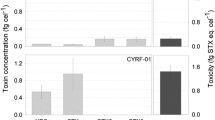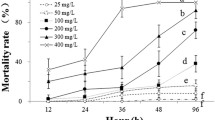Abstract.
Toxic cyanobacteria occur in fresh, brackish, and marine waters worldwide. Harmful effects of intact cyanobacterial cells on zooplankton are well known, but only a few studies have focused on the effects of dissolved toxins. We investigated experimentally how the cyanobacterial toxins anatoxin-a, microcystin-LR, and nodularin affect estuarine calanoid copepods, by monitoring effects on egg hatching and survival in Eurytemora affinis. We also investigated effects of nodularin on the survival of Acartia bifilosa. All exposures were carried out using purified dissolved toxins. We found that the egg hatching was unaffected by these toxins, whereas survival was marginally affected by high concentrations of anatoxin-a and nodularin. For microcystin-LR, we found reduced survival at concentrations that were lower than those known to affect other meso-zooplankton.
Similar content being viewed by others
Author information
Authors and Affiliations
Additional information
Electronic Publication
Rights and permissions
About this article
Cite this article
Reinikainen, .M., Lindvall, .F., Meriluoto, .J. et al. Effects of dissolved cyanobacterial toxins on the survival and egg hatching of estuarine calanoid copepods. Marine Biology 140, 577–583 (2002). https://doi.org/10.1007/s00227-001-0720-6
Received:
Accepted:
Issue Date:
DOI: https://doi.org/10.1007/s00227-001-0720-6




